Decision-Making Models: Smart Drone Delivery Case Study Analysis
VerifiedAdded on 2021/04/17
|19
|4451
|300
Report
AI Summary
This report delves into the realm of decision-making models, exploring their significance within organizational contexts. It begins by defining decision-making models and highlighting their critical role in achieving effective outcomes. The report then provides an in-depth analysis of three key decision-making models: the rational decision-making model, the bounded rationality model, and the retrospective decision-making model. A significant portion of the report is dedicated to a case study of smart drone delivery, specifically focusing on the Zipline company's application of the bounded rationality model. The report evaluates the value added to the business through this model, detailing its advantages and disadvantages. Furthermore, the report proposes the application of both rational and retrospective decision-making models within the drone delivery industry, outlining the necessary steps and considerations for successful implementation. The report also includes an application section that applies regression analysis and decision trees to the drone delivery business. Finally, the report concludes with a summary of the key findings and implications of decision-making models in the business context.
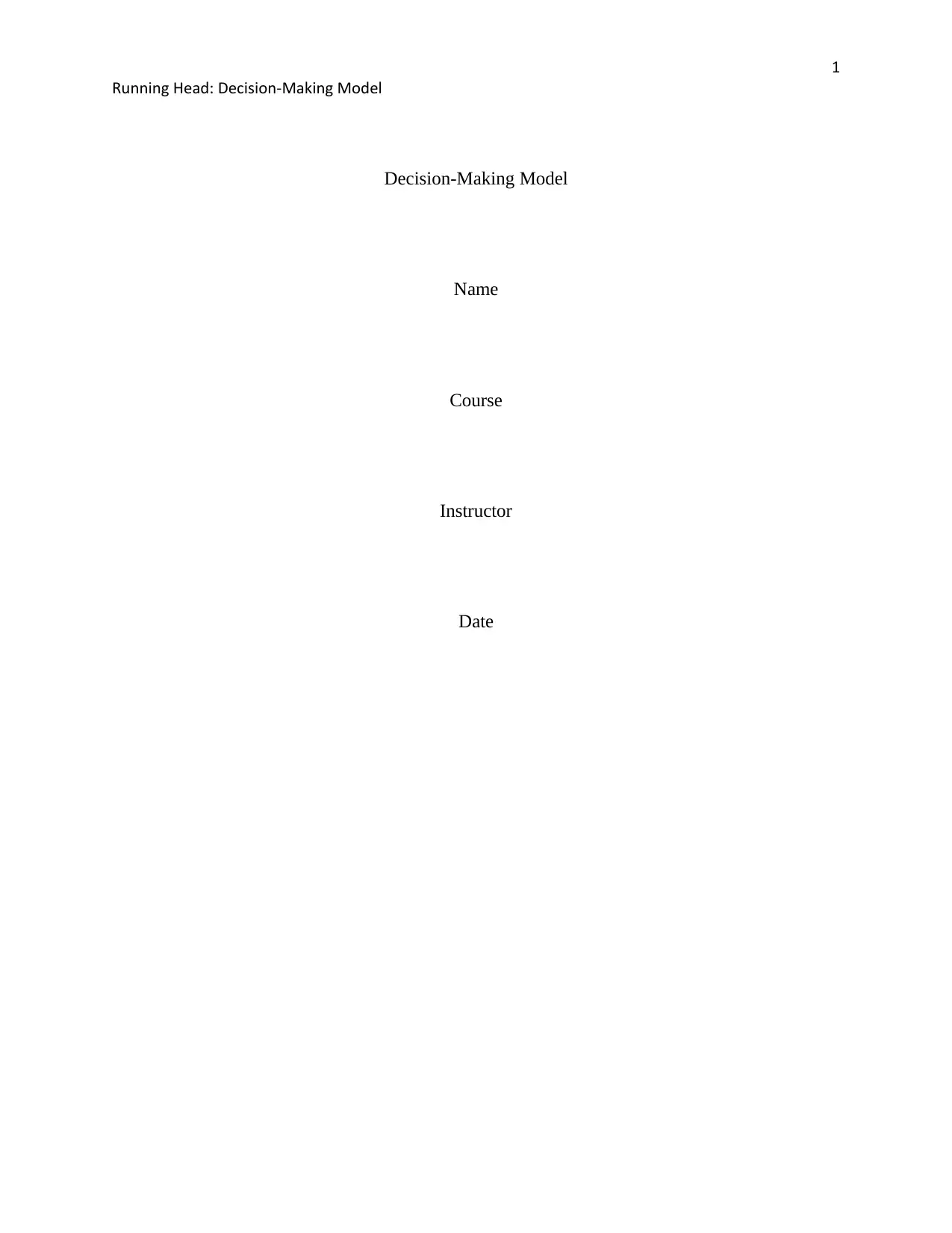
1
Running Head: Decision-Making Model
Decision-Making Model
Name
Course
Instructor
Date
Running Head: Decision-Making Model
Decision-Making Model
Name
Course
Instructor
Date
Paraphrase This Document
Need a fresh take? Get an instant paraphrase of this document with our AI Paraphraser
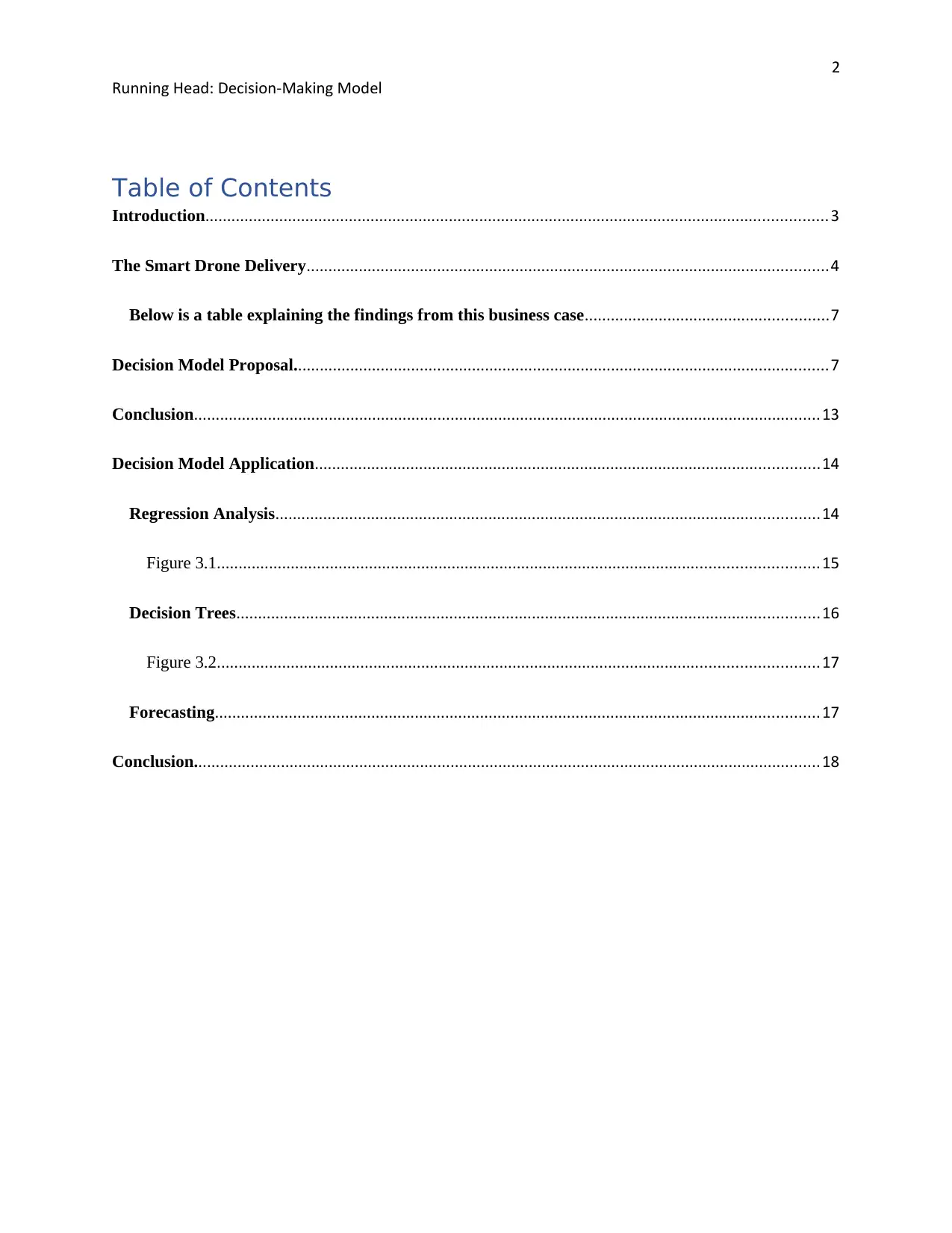
2
Running Head: Decision-Making Model
Table of Contents
Introduction...............................................................................................................................................3
The Smart Drone Delivery........................................................................................................................4
Below is a table explaining the findings from this business case........................................................7
Decision Model Proposal...........................................................................................................................7
Conclusion................................................................................................................................................13
Decision Model Application....................................................................................................................14
Regression Analysis.............................................................................................................................14
Figure 3.1..........................................................................................................................................15
Decision Trees......................................................................................................................................16
Figure 3.2..........................................................................................................................................17
Forecasting...........................................................................................................................................17
Conclusion................................................................................................................................................18
Running Head: Decision-Making Model
Table of Contents
Introduction...............................................................................................................................................3
The Smart Drone Delivery........................................................................................................................4
Below is a table explaining the findings from this business case........................................................7
Decision Model Proposal...........................................................................................................................7
Conclusion................................................................................................................................................13
Decision Model Application....................................................................................................................14
Regression Analysis.............................................................................................................................14
Figure 3.1..........................................................................................................................................15
Decision Trees......................................................................................................................................16
Figure 3.2..........................................................................................................................................17
Forecasting...........................................................................................................................................17
Conclusion................................................................................................................................................18
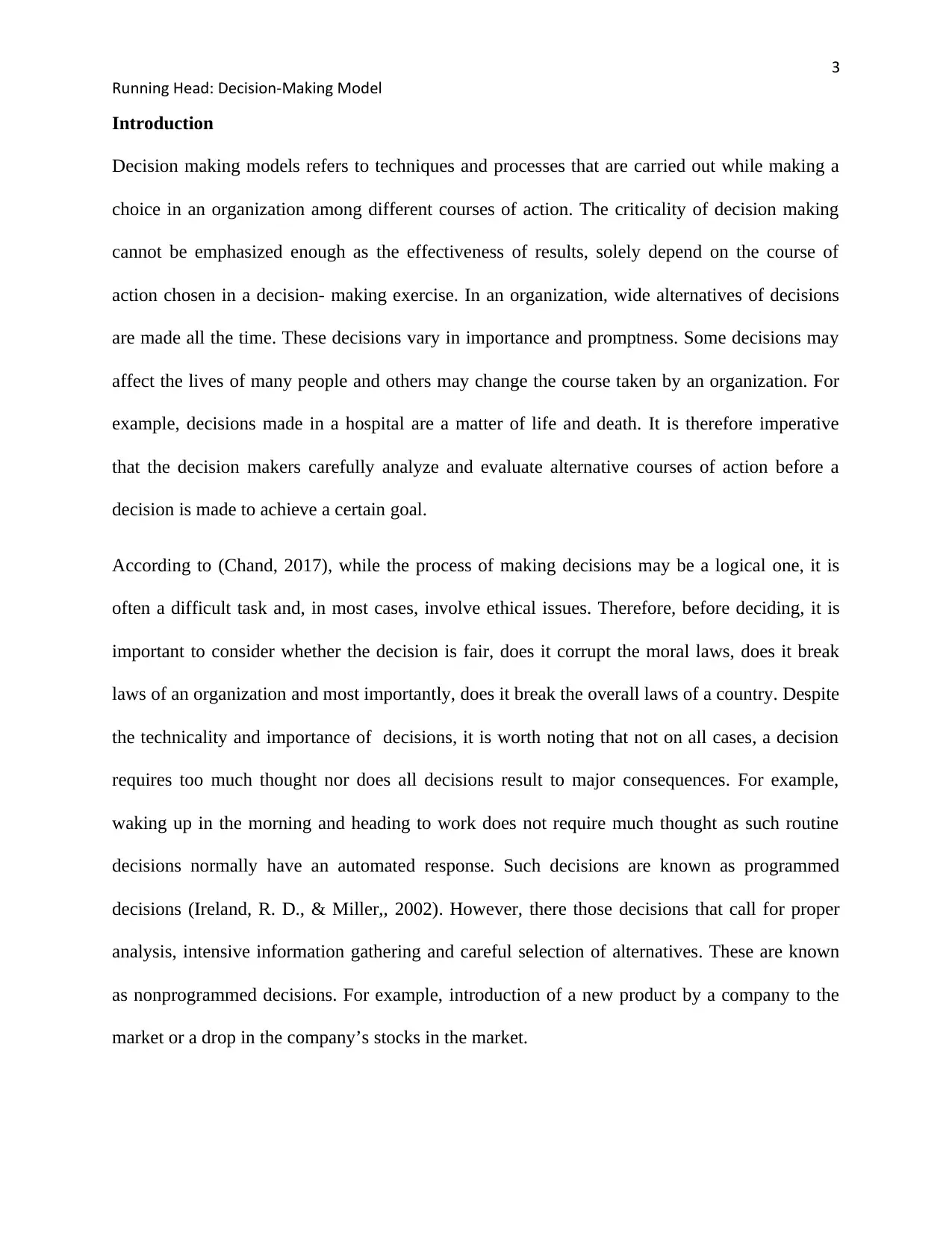
3
Running Head: Decision-Making Model
Introduction
Decision making models refers to techniques and processes that are carried out while making a
choice in an organization among different courses of action. The criticality of decision making
cannot be emphasized enough as the effectiveness of results, solely depend on the course of
action chosen in a decision- making exercise. In an organization, wide alternatives of decisions
are made all the time. These decisions vary in importance and promptness. Some decisions may
affect the lives of many people and others may change the course taken by an organization. For
example, decisions made in a hospital are a matter of life and death. It is therefore imperative
that the decision makers carefully analyze and evaluate alternative courses of action before a
decision is made to achieve a certain goal.
According to (Chand, 2017), while the process of making decisions may be a logical one, it is
often a difficult task and, in most cases, involve ethical issues. Therefore, before deciding, it is
important to consider whether the decision is fair, does it corrupt the moral laws, does it break
laws of an organization and most importantly, does it break the overall laws of a country. Despite
the technicality and importance of decisions, it is worth noting that not on all cases, a decision
requires too much thought nor does all decisions result to major consequences. For example,
waking up in the morning and heading to work does not require much thought as such routine
decisions normally have an automated response. Such decisions are known as programmed
decisions (Ireland, R. D., & Miller,, 2002). However, there those decisions that call for proper
analysis, intensive information gathering and careful selection of alternatives. These are known
as nonprogrammed decisions. For example, introduction of a new product by a company to the
market or a drop in the company’s stocks in the market.
Running Head: Decision-Making Model
Introduction
Decision making models refers to techniques and processes that are carried out while making a
choice in an organization among different courses of action. The criticality of decision making
cannot be emphasized enough as the effectiveness of results, solely depend on the course of
action chosen in a decision- making exercise. In an organization, wide alternatives of decisions
are made all the time. These decisions vary in importance and promptness. Some decisions may
affect the lives of many people and others may change the course taken by an organization. For
example, decisions made in a hospital are a matter of life and death. It is therefore imperative
that the decision makers carefully analyze and evaluate alternative courses of action before a
decision is made to achieve a certain goal.
According to (Chand, 2017), while the process of making decisions may be a logical one, it is
often a difficult task and, in most cases, involve ethical issues. Therefore, before deciding, it is
important to consider whether the decision is fair, does it corrupt the moral laws, does it break
laws of an organization and most importantly, does it break the overall laws of a country. Despite
the technicality and importance of decisions, it is worth noting that not on all cases, a decision
requires too much thought nor does all decisions result to major consequences. For example,
waking up in the morning and heading to work does not require much thought as such routine
decisions normally have an automated response. Such decisions are known as programmed
decisions (Ireland, R. D., & Miller,, 2002). However, there those decisions that call for proper
analysis, intensive information gathering and careful selection of alternatives. These are known
as nonprogrammed decisions. For example, introduction of a new product by a company to the
market or a drop in the company’s stocks in the market.
⊘ This is a preview!⊘
Do you want full access?
Subscribe today to unlock all pages.

Trusted by 1+ million students worldwide
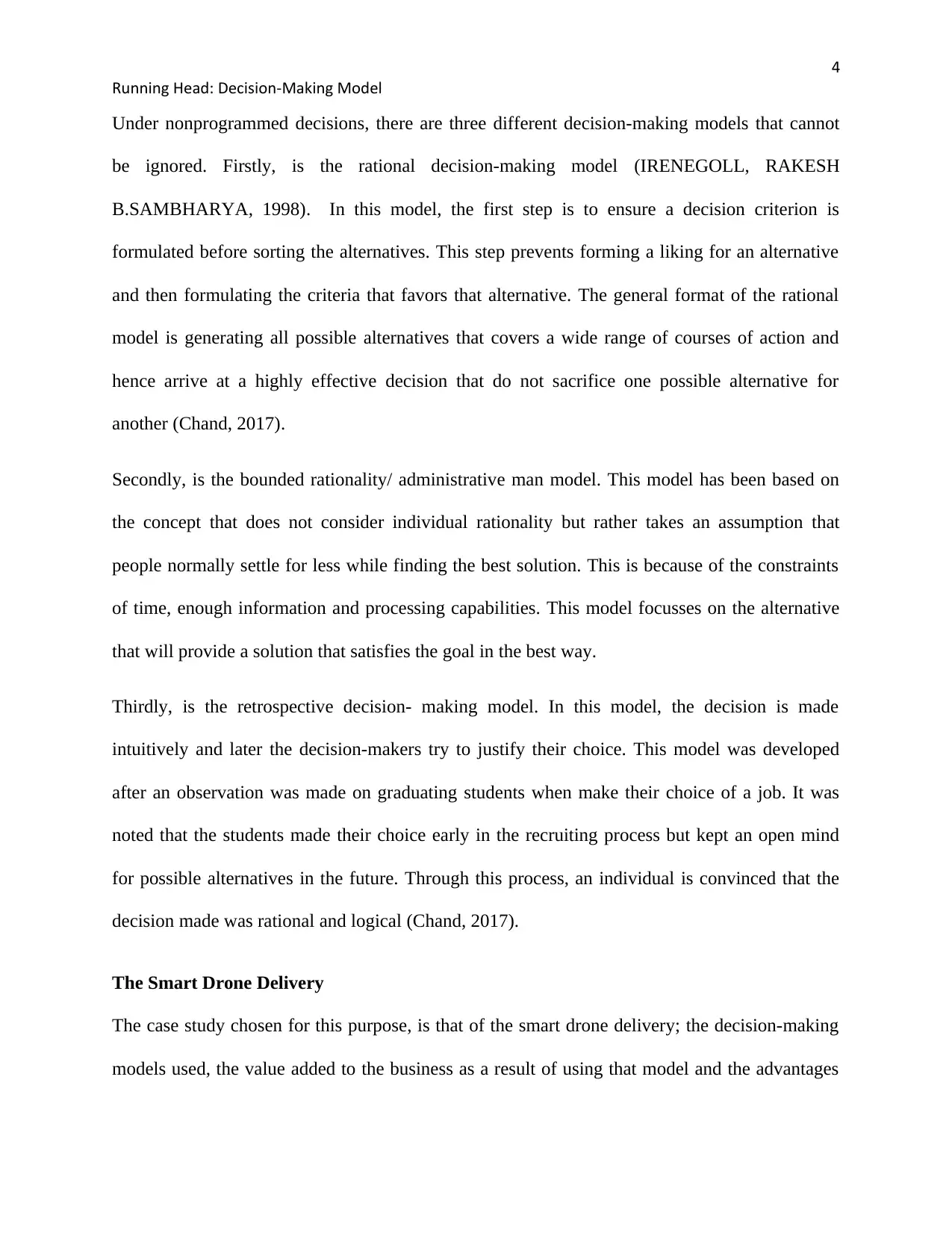
4
Running Head: Decision-Making Model
Under nonprogrammed decisions, there are three different decision-making models that cannot
be ignored. Firstly, is the rational decision-making model (IRENEGOLL, RAKESH
B.SAMBHARYA, 1998). In this model, the first step is to ensure a decision criterion is
formulated before sorting the alternatives. This step prevents forming a liking for an alternative
and then formulating the criteria that favors that alternative. The general format of the rational
model is generating all possible alternatives that covers a wide range of courses of action and
hence arrive at a highly effective decision that do not sacrifice one possible alternative for
another (Chand, 2017).
Secondly, is the bounded rationality/ administrative man model. This model has been based on
the concept that does not consider individual rationality but rather takes an assumption that
people normally settle for less while finding the best solution. This is because of the constraints
of time, enough information and processing capabilities. This model focusses on the alternative
that will provide a solution that satisfies the goal in the best way.
Thirdly, is the retrospective decision- making model. In this model, the decision is made
intuitively and later the decision-makers try to justify their choice. This model was developed
after an observation was made on graduating students when make their choice of a job. It was
noted that the students made their choice early in the recruiting process but kept an open mind
for possible alternatives in the future. Through this process, an individual is convinced that the
decision made was rational and logical (Chand, 2017).
The Smart Drone Delivery
The case study chosen for this purpose, is that of the smart drone delivery; the decision-making
models used, the value added to the business as a result of using that model and the advantages
Running Head: Decision-Making Model
Under nonprogrammed decisions, there are three different decision-making models that cannot
be ignored. Firstly, is the rational decision-making model (IRENEGOLL, RAKESH
B.SAMBHARYA, 1998). In this model, the first step is to ensure a decision criterion is
formulated before sorting the alternatives. This step prevents forming a liking for an alternative
and then formulating the criteria that favors that alternative. The general format of the rational
model is generating all possible alternatives that covers a wide range of courses of action and
hence arrive at a highly effective decision that do not sacrifice one possible alternative for
another (Chand, 2017).
Secondly, is the bounded rationality/ administrative man model. This model has been based on
the concept that does not consider individual rationality but rather takes an assumption that
people normally settle for less while finding the best solution. This is because of the constraints
of time, enough information and processing capabilities. This model focusses on the alternative
that will provide a solution that satisfies the goal in the best way.
Thirdly, is the retrospective decision- making model. In this model, the decision is made
intuitively and later the decision-makers try to justify their choice. This model was developed
after an observation was made on graduating students when make their choice of a job. It was
noted that the students made their choice early in the recruiting process but kept an open mind
for possible alternatives in the future. Through this process, an individual is convinced that the
decision made was rational and logical (Chand, 2017).
The Smart Drone Delivery
The case study chosen for this purpose, is that of the smart drone delivery; the decision-making
models used, the value added to the business as a result of using that model and the advantages
Paraphrase This Document
Need a fresh take? Get an instant paraphrase of this document with our AI Paraphraser
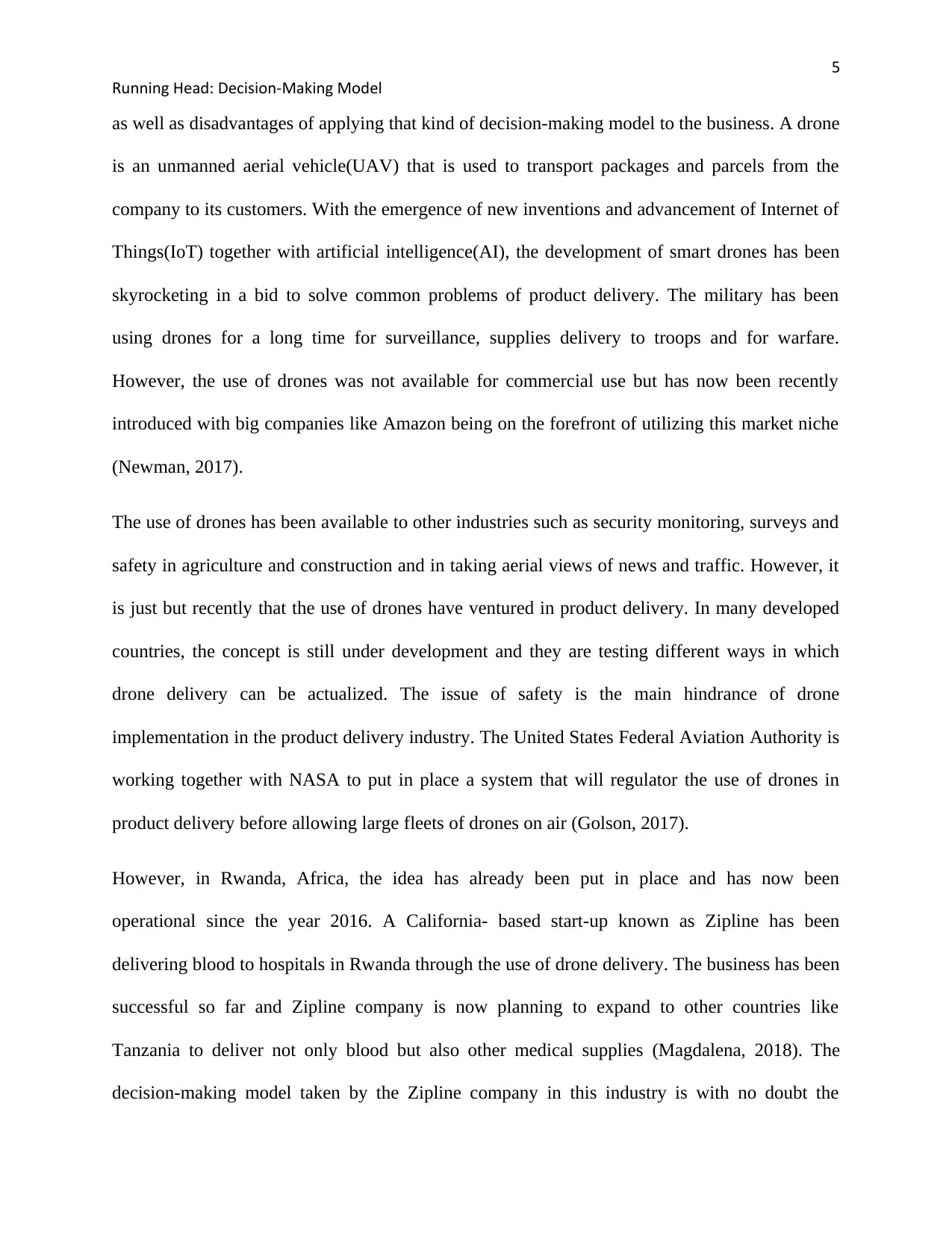
5
Running Head: Decision-Making Model
as well as disadvantages of applying that kind of decision-making model to the business. A drone
is an unmanned aerial vehicle(UAV) that is used to transport packages and parcels from the
company to its customers. With the emergence of new inventions and advancement of Internet of
Things(IoT) together with artificial intelligence(AI), the development of smart drones has been
skyrocketing in a bid to solve common problems of product delivery. The military has been
using drones for a long time for surveillance, supplies delivery to troops and for warfare.
However, the use of drones was not available for commercial use but has now been recently
introduced with big companies like Amazon being on the forefront of utilizing this market niche
(Newman, 2017).
The use of drones has been available to other industries such as security monitoring, surveys and
safety in agriculture and construction and in taking aerial views of news and traffic. However, it
is just but recently that the use of drones have ventured in product delivery. In many developed
countries, the concept is still under development and they are testing different ways in which
drone delivery can be actualized. The issue of safety is the main hindrance of drone
implementation in the product delivery industry. The United States Federal Aviation Authority is
working together with NASA to put in place a system that will regulator the use of drones in
product delivery before allowing large fleets of drones on air (Golson, 2017).
However, in Rwanda, Africa, the idea has already been put in place and has now been
operational since the year 2016. A California- based start-up known as Zipline has been
delivering blood to hospitals in Rwanda through the use of drone delivery. The business has been
successful so far and Zipline company is now planning to expand to other countries like
Tanzania to deliver not only blood but also other medical supplies (Magdalena, 2018). The
decision-making model taken by the Zipline company in this industry is with no doubt the
Running Head: Decision-Making Model
as well as disadvantages of applying that kind of decision-making model to the business. A drone
is an unmanned aerial vehicle(UAV) that is used to transport packages and parcels from the
company to its customers. With the emergence of new inventions and advancement of Internet of
Things(IoT) together with artificial intelligence(AI), the development of smart drones has been
skyrocketing in a bid to solve common problems of product delivery. The military has been
using drones for a long time for surveillance, supplies delivery to troops and for warfare.
However, the use of drones was not available for commercial use but has now been recently
introduced with big companies like Amazon being on the forefront of utilizing this market niche
(Newman, 2017).
The use of drones has been available to other industries such as security monitoring, surveys and
safety in agriculture and construction and in taking aerial views of news and traffic. However, it
is just but recently that the use of drones have ventured in product delivery. In many developed
countries, the concept is still under development and they are testing different ways in which
drone delivery can be actualized. The issue of safety is the main hindrance of drone
implementation in the product delivery industry. The United States Federal Aviation Authority is
working together with NASA to put in place a system that will regulator the use of drones in
product delivery before allowing large fleets of drones on air (Golson, 2017).
However, in Rwanda, Africa, the idea has already been put in place and has now been
operational since the year 2016. A California- based start-up known as Zipline has been
delivering blood to hospitals in Rwanda through the use of drone delivery. The business has been
successful so far and Zipline company is now planning to expand to other countries like
Tanzania to deliver not only blood but also other medical supplies (Magdalena, 2018). The
decision-making model taken by the Zipline company in this industry is with no doubt the
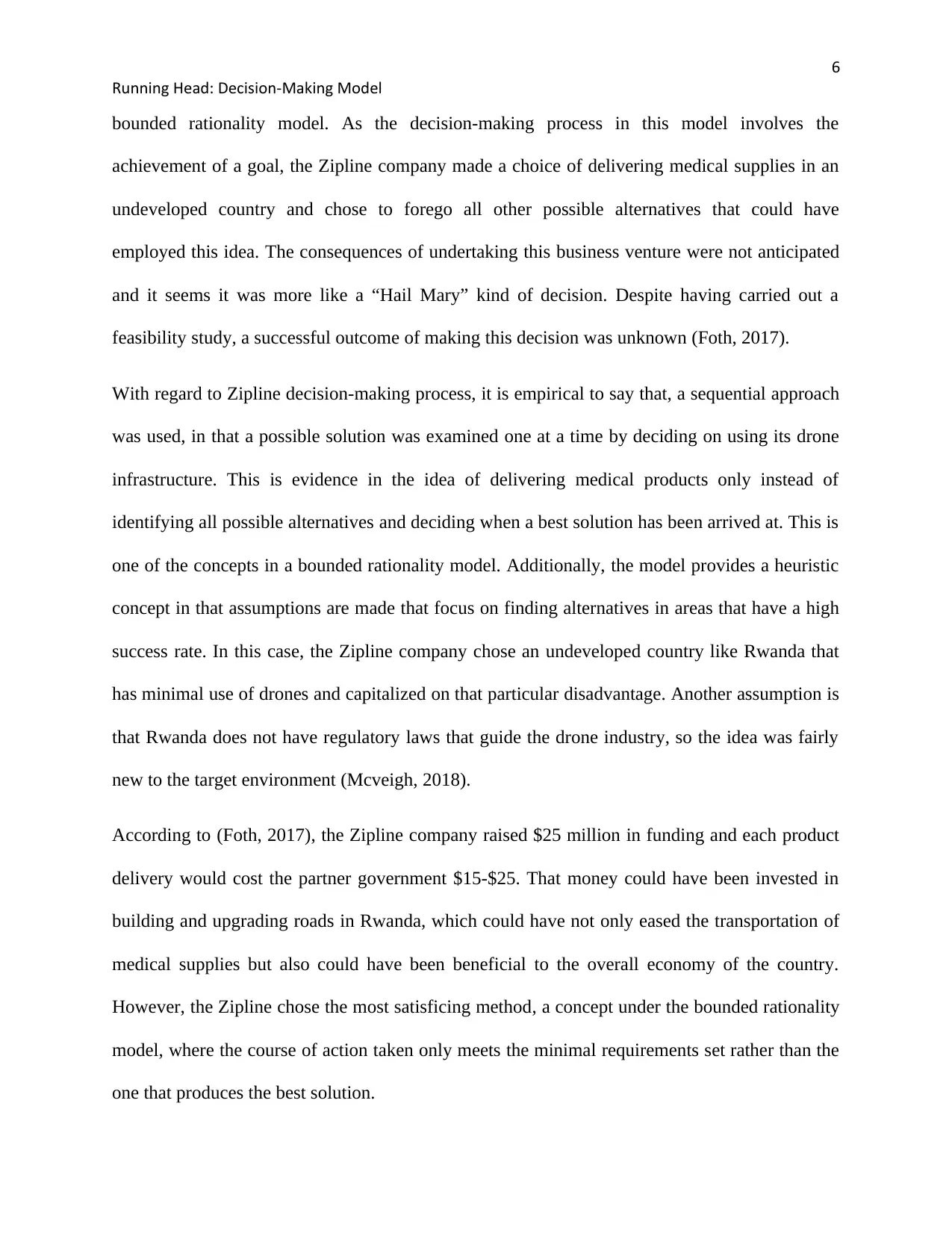
6
Running Head: Decision-Making Model
bounded rationality model. As the decision-making process in this model involves the
achievement of a goal, the Zipline company made a choice of delivering medical supplies in an
undeveloped country and chose to forego all other possible alternatives that could have
employed this idea. The consequences of undertaking this business venture were not anticipated
and it seems it was more like a “Hail Mary” kind of decision. Despite having carried out a
feasibility study, a successful outcome of making this decision was unknown (Foth, 2017).
With regard to Zipline decision-making process, it is empirical to say that, a sequential approach
was used, in that a possible solution was examined one at a time by deciding on using its drone
infrastructure. This is evidence in the idea of delivering medical products only instead of
identifying all possible alternatives and deciding when a best solution has been arrived at. This is
one of the concepts in a bounded rationality model. Additionally, the model provides a heuristic
concept in that assumptions are made that focus on finding alternatives in areas that have a high
success rate. In this case, the Zipline company chose an undeveloped country like Rwanda that
has minimal use of drones and capitalized on that particular disadvantage. Another assumption is
that Rwanda does not have regulatory laws that guide the drone industry, so the idea was fairly
new to the target environment (Mcveigh, 2018).
According to (Foth, 2017), the Zipline company raised $25 million in funding and each product
delivery would cost the partner government $15-$25. That money could have been invested in
building and upgrading roads in Rwanda, which could have not only eased the transportation of
medical supplies but also could have been beneficial to the overall economy of the country.
However, the Zipline chose the most satisficing method, a concept under the bounded rationality
model, where the course of action taken only meets the minimal requirements set rather than the
one that produces the best solution.
Running Head: Decision-Making Model
bounded rationality model. As the decision-making process in this model involves the
achievement of a goal, the Zipline company made a choice of delivering medical supplies in an
undeveloped country and chose to forego all other possible alternatives that could have
employed this idea. The consequences of undertaking this business venture were not anticipated
and it seems it was more like a “Hail Mary” kind of decision. Despite having carried out a
feasibility study, a successful outcome of making this decision was unknown (Foth, 2017).
With regard to Zipline decision-making process, it is empirical to say that, a sequential approach
was used, in that a possible solution was examined one at a time by deciding on using its drone
infrastructure. This is evidence in the idea of delivering medical products only instead of
identifying all possible alternatives and deciding when a best solution has been arrived at. This is
one of the concepts in a bounded rationality model. Additionally, the model provides a heuristic
concept in that assumptions are made that focus on finding alternatives in areas that have a high
success rate. In this case, the Zipline company chose an undeveloped country like Rwanda that
has minimal use of drones and capitalized on that particular disadvantage. Another assumption is
that Rwanda does not have regulatory laws that guide the drone industry, so the idea was fairly
new to the target environment (Mcveigh, 2018).
According to (Foth, 2017), the Zipline company raised $25 million in funding and each product
delivery would cost the partner government $15-$25. That money could have been invested in
building and upgrading roads in Rwanda, which could have not only eased the transportation of
medical supplies but also could have been beneficial to the overall economy of the country.
However, the Zipline chose the most satisficing method, a concept under the bounded rationality
model, where the course of action taken only meets the minimal requirements set rather than the
one that produces the best solution.
⊘ This is a preview!⊘
Do you want full access?
Subscribe today to unlock all pages.

Trusted by 1+ million students worldwide
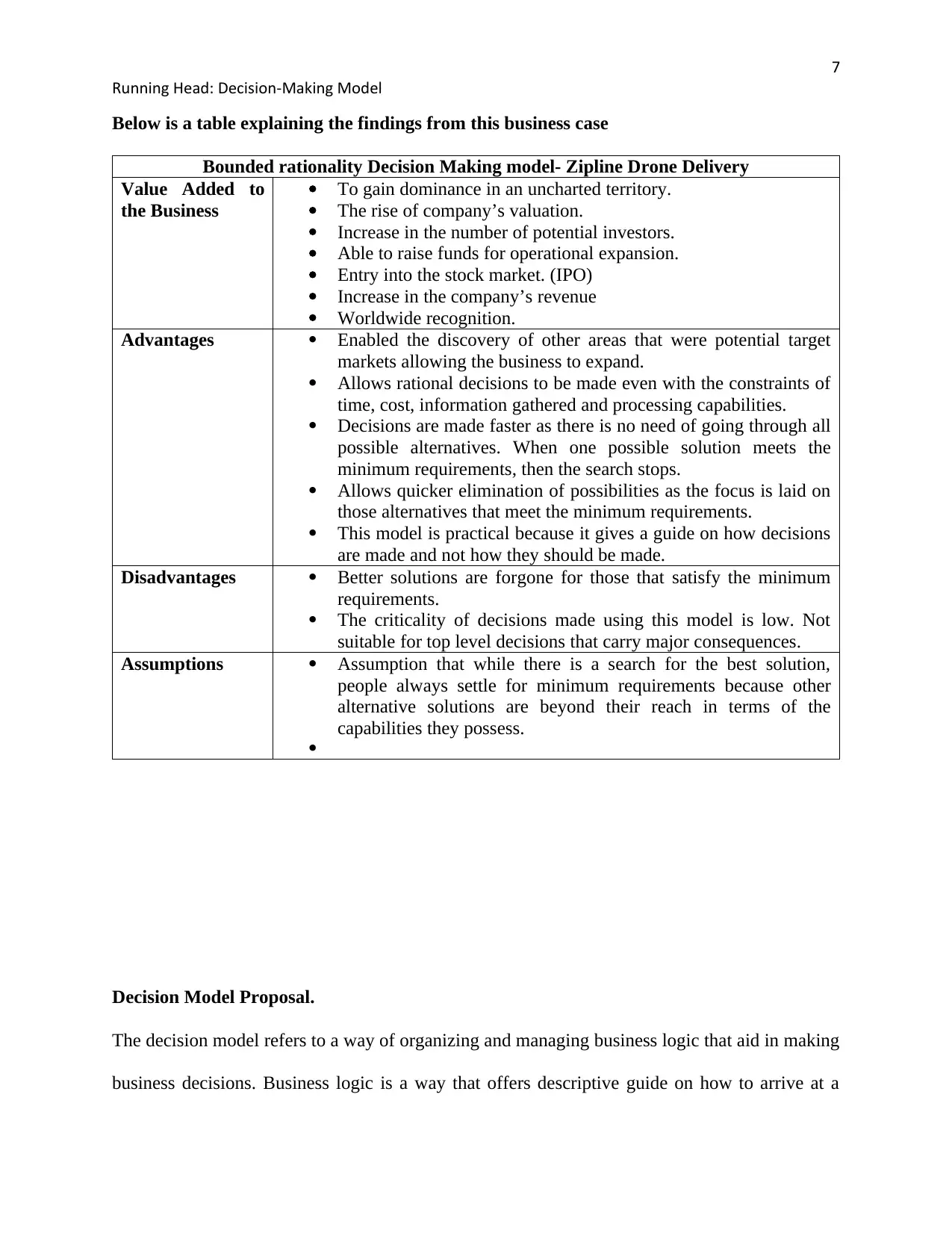
7
Running Head: Decision-Making Model
Below is a table explaining the findings from this business case
Bounded rationality Decision Making model- Zipline Drone Delivery
Value Added to
the Business
To gain dominance in an uncharted territory.
The rise of company’s valuation.
Increase in the number of potential investors.
Able to raise funds for operational expansion.
Entry into the stock market. (IPO)
Increase in the company’s revenue
Worldwide recognition.
Advantages Enabled the discovery of other areas that were potential target
markets allowing the business to expand.
Allows rational decisions to be made even with the constraints of
time, cost, information gathered and processing capabilities.
Decisions are made faster as there is no need of going through all
possible alternatives. When one possible solution meets the
minimum requirements, then the search stops.
Allows quicker elimination of possibilities as the focus is laid on
those alternatives that meet the minimum requirements.
This model is practical because it gives a guide on how decisions
are made and not how they should be made.
Disadvantages Better solutions are forgone for those that satisfy the minimum
requirements.
The criticality of decisions made using this model is low. Not
suitable for top level decisions that carry major consequences.
Assumptions Assumption that while there is a search for the best solution,
people always settle for minimum requirements because other
alternative solutions are beyond their reach in terms of the
capabilities they possess.
Decision Model Proposal.
The decision model refers to a way of organizing and managing business logic that aid in making
business decisions. Business logic is a way that offers descriptive guide on how to arrive at a
Running Head: Decision-Making Model
Below is a table explaining the findings from this business case
Bounded rationality Decision Making model- Zipline Drone Delivery
Value Added to
the Business
To gain dominance in an uncharted territory.
The rise of company’s valuation.
Increase in the number of potential investors.
Able to raise funds for operational expansion.
Entry into the stock market. (IPO)
Increase in the company’s revenue
Worldwide recognition.
Advantages Enabled the discovery of other areas that were potential target
markets allowing the business to expand.
Allows rational decisions to be made even with the constraints of
time, cost, information gathered and processing capabilities.
Decisions are made faster as there is no need of going through all
possible alternatives. When one possible solution meets the
minimum requirements, then the search stops.
Allows quicker elimination of possibilities as the focus is laid on
those alternatives that meet the minimum requirements.
This model is practical because it gives a guide on how decisions
are made and not how they should be made.
Disadvantages Better solutions are forgone for those that satisfy the minimum
requirements.
The criticality of decisions made using this model is low. Not
suitable for top level decisions that carry major consequences.
Assumptions Assumption that while there is a search for the best solution,
people always settle for minimum requirements because other
alternative solutions are beyond their reach in terms of the
capabilities they possess.
Decision Model Proposal.
The decision model refers to a way of organizing and managing business logic that aid in making
business decisions. Business logic is a way that offers descriptive guide on how to arrive at a
Paraphrase This Document
Need a fresh take? Get an instant paraphrase of this document with our AI Paraphraser
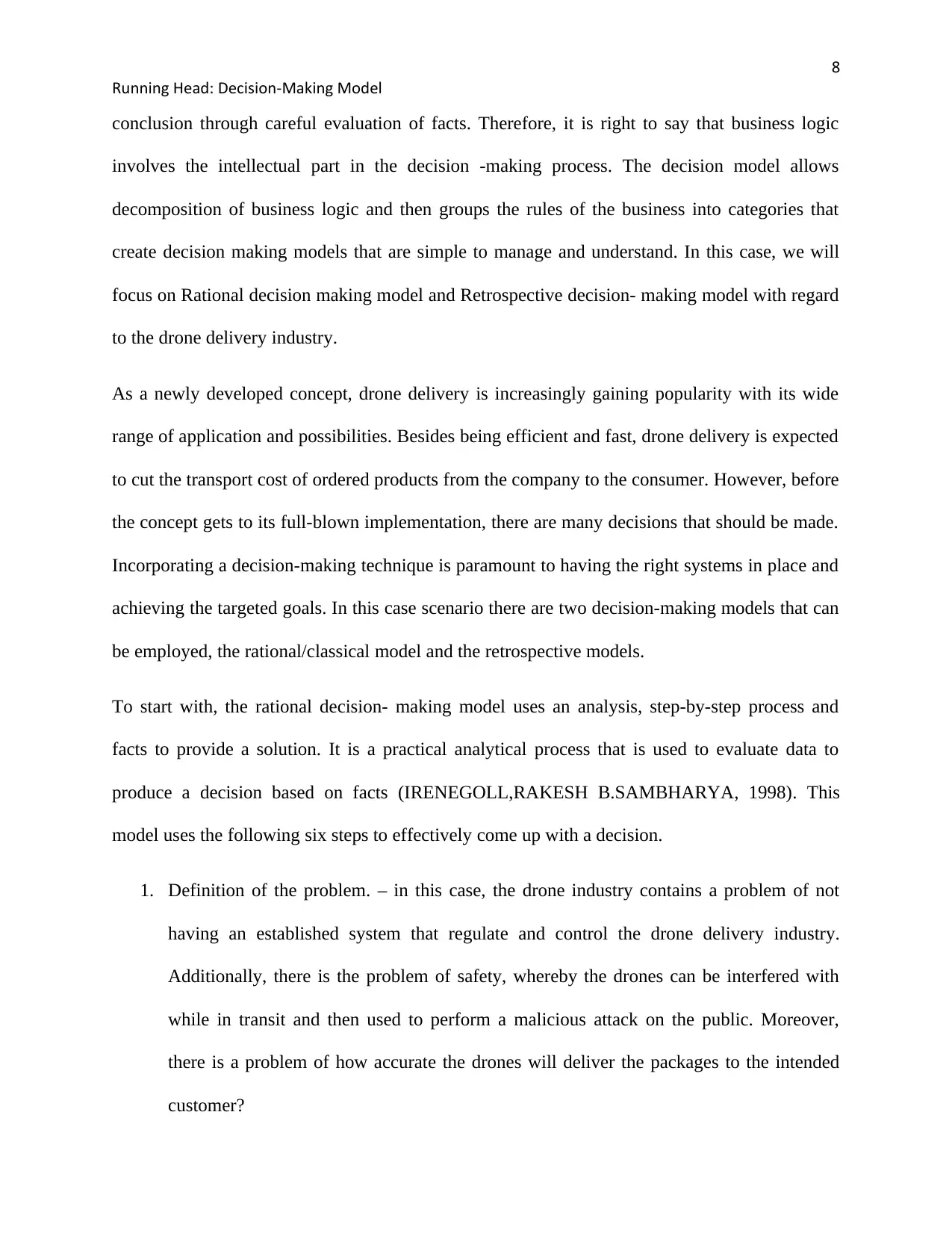
8
Running Head: Decision-Making Model
conclusion through careful evaluation of facts. Therefore, it is right to say that business logic
involves the intellectual part in the decision -making process. The decision model allows
decomposition of business logic and then groups the rules of the business into categories that
create decision making models that are simple to manage and understand. In this case, we will
focus on Rational decision making model and Retrospective decision- making model with regard
to the drone delivery industry.
As a newly developed concept, drone delivery is increasingly gaining popularity with its wide
range of application and possibilities. Besides being efficient and fast, drone delivery is expected
to cut the transport cost of ordered products from the company to the consumer. However, before
the concept gets to its full-blown implementation, there are many decisions that should be made.
Incorporating a decision-making technique is paramount to having the right systems in place and
achieving the targeted goals. In this case scenario there are two decision-making models that can
be employed, the rational/classical model and the retrospective models.
To start with, the rational decision- making model uses an analysis, step-by-step process and
facts to provide a solution. It is a practical analytical process that is used to evaluate data to
produce a decision based on facts (IRENEGOLL,RAKESH B.SAMBHARYA, 1998). This
model uses the following six steps to effectively come up with a decision.
1. Definition of the problem. – in this case, the drone industry contains a problem of not
having an established system that regulate and control the drone delivery industry.
Additionally, there is the problem of safety, whereby the drones can be interfered with
while in transit and then used to perform a malicious attack on the public. Moreover,
there is a problem of how accurate the drones will deliver the packages to the intended
customer?
Running Head: Decision-Making Model
conclusion through careful evaluation of facts. Therefore, it is right to say that business logic
involves the intellectual part in the decision -making process. The decision model allows
decomposition of business logic and then groups the rules of the business into categories that
create decision making models that are simple to manage and understand. In this case, we will
focus on Rational decision making model and Retrospective decision- making model with regard
to the drone delivery industry.
As a newly developed concept, drone delivery is increasingly gaining popularity with its wide
range of application and possibilities. Besides being efficient and fast, drone delivery is expected
to cut the transport cost of ordered products from the company to the consumer. However, before
the concept gets to its full-blown implementation, there are many decisions that should be made.
Incorporating a decision-making technique is paramount to having the right systems in place and
achieving the targeted goals. In this case scenario there are two decision-making models that can
be employed, the rational/classical model and the retrospective models.
To start with, the rational decision- making model uses an analysis, step-by-step process and
facts to provide a solution. It is a practical analytical process that is used to evaluate data to
produce a decision based on facts (IRENEGOLL,RAKESH B.SAMBHARYA, 1998). This
model uses the following six steps to effectively come up with a decision.
1. Definition of the problem. – in this case, the drone industry contains a problem of not
having an established system that regulate and control the drone delivery industry.
Additionally, there is the problem of safety, whereby the drones can be interfered with
while in transit and then used to perform a malicious attack on the public. Moreover,
there is a problem of how accurate the drones will deliver the packages to the intended
customer?
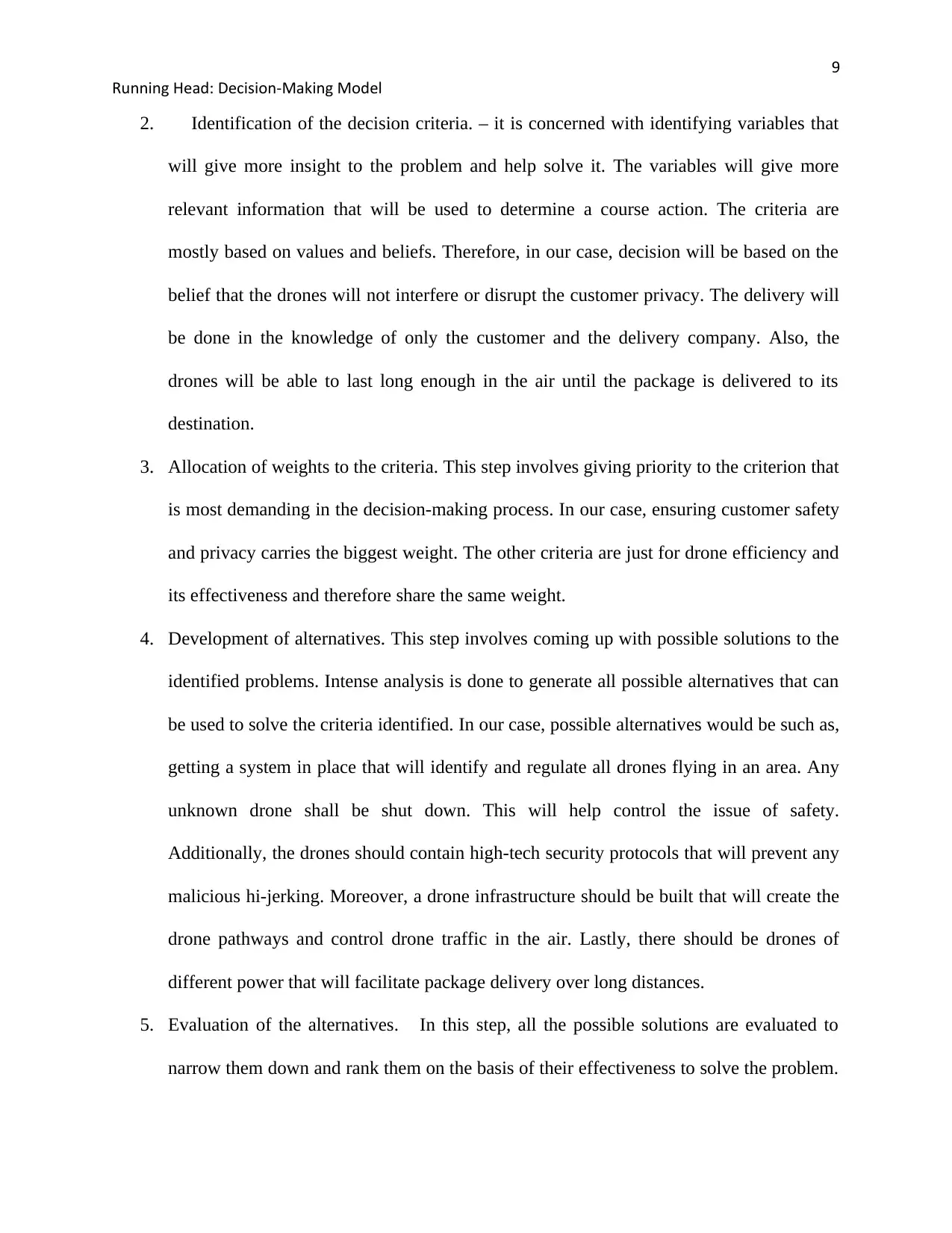
9
Running Head: Decision-Making Model
2. Identification of the decision criteria. – it is concerned with identifying variables that
will give more insight to the problem and help solve it. The variables will give more
relevant information that will be used to determine a course action. The criteria are
mostly based on values and beliefs. Therefore, in our case, decision will be based on the
belief that the drones will not interfere or disrupt the customer privacy. The delivery will
be done in the knowledge of only the customer and the delivery company. Also, the
drones will be able to last long enough in the air until the package is delivered to its
destination.
3. Allocation of weights to the criteria. This step involves giving priority to the criterion that
is most demanding in the decision-making process. In our case, ensuring customer safety
and privacy carries the biggest weight. The other criteria are just for drone efficiency and
its effectiveness and therefore share the same weight.
4. Development of alternatives. This step involves coming up with possible solutions to the
identified problems. Intense analysis is done to generate all possible alternatives that can
be used to solve the criteria identified. In our case, possible alternatives would be such as,
getting a system in place that will identify and regulate all drones flying in an area. Any
unknown drone shall be shut down. This will help control the issue of safety.
Additionally, the drones should contain high-tech security protocols that will prevent any
malicious hi-jerking. Moreover, a drone infrastructure should be built that will create the
drone pathways and control drone traffic in the air. Lastly, there should be drones of
different power that will facilitate package delivery over long distances.
5. Evaluation of the alternatives. In this step, all the possible solutions are evaluated to
narrow them down and rank them on the basis of their effectiveness to solve the problem.
Running Head: Decision-Making Model
2. Identification of the decision criteria. – it is concerned with identifying variables that
will give more insight to the problem and help solve it. The variables will give more
relevant information that will be used to determine a course action. The criteria are
mostly based on values and beliefs. Therefore, in our case, decision will be based on the
belief that the drones will not interfere or disrupt the customer privacy. The delivery will
be done in the knowledge of only the customer and the delivery company. Also, the
drones will be able to last long enough in the air until the package is delivered to its
destination.
3. Allocation of weights to the criteria. This step involves giving priority to the criterion that
is most demanding in the decision-making process. In our case, ensuring customer safety
and privacy carries the biggest weight. The other criteria are just for drone efficiency and
its effectiveness and therefore share the same weight.
4. Development of alternatives. This step involves coming up with possible solutions to the
identified problems. Intense analysis is done to generate all possible alternatives that can
be used to solve the criteria identified. In our case, possible alternatives would be such as,
getting a system in place that will identify and regulate all drones flying in an area. Any
unknown drone shall be shut down. This will help control the issue of safety.
Additionally, the drones should contain high-tech security protocols that will prevent any
malicious hi-jerking. Moreover, a drone infrastructure should be built that will create the
drone pathways and control drone traffic in the air. Lastly, there should be drones of
different power that will facilitate package delivery over long distances.
5. Evaluation of the alternatives. In this step, all the possible solutions are evaluated to
narrow them down and rank them on the basis of their effectiveness to solve the problem.
⊘ This is a preview!⊘
Do you want full access?
Subscribe today to unlock all pages.

Trusted by 1+ million students worldwide
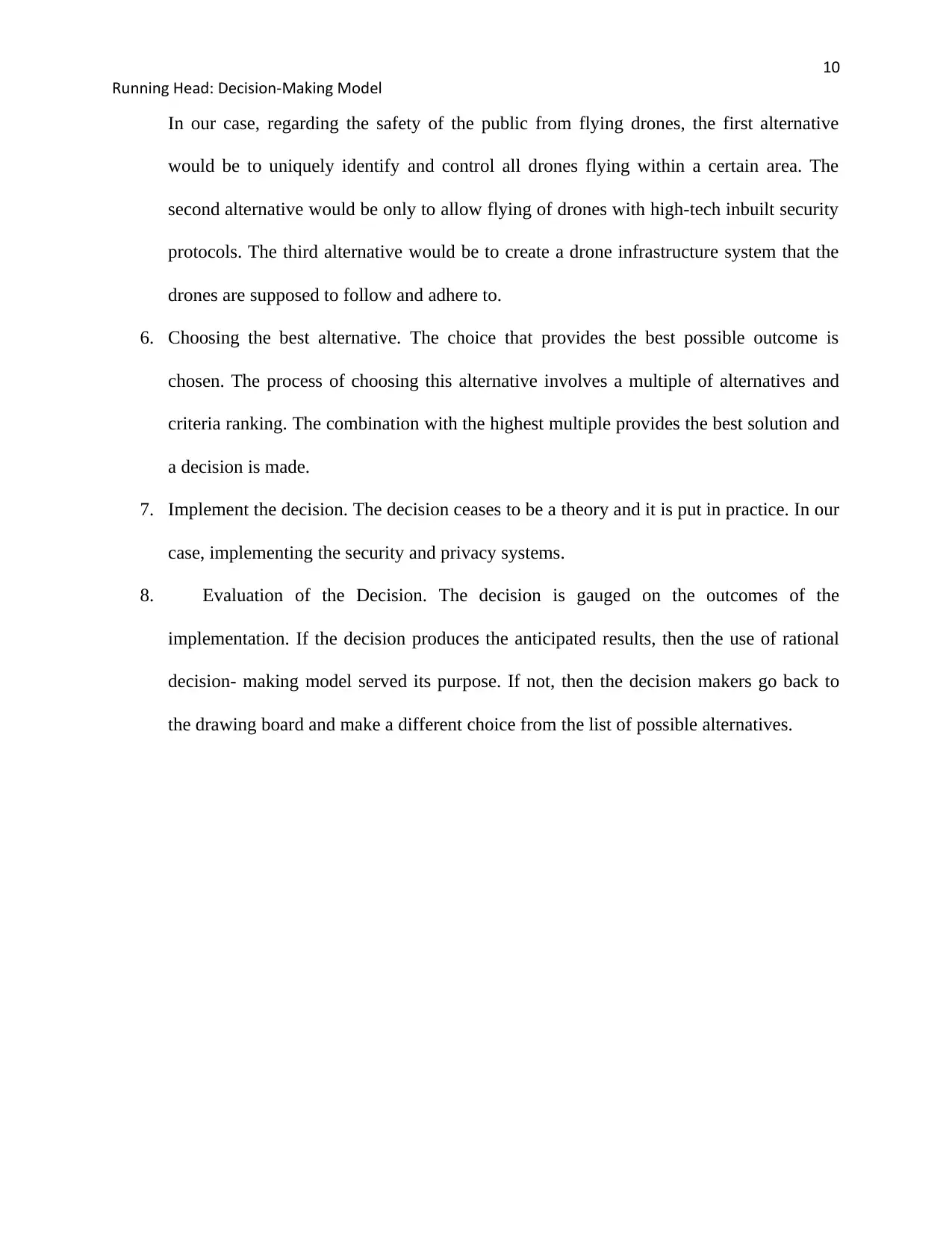
10
Running Head: Decision-Making Model
In our case, regarding the safety of the public from flying drones, the first alternative
would be to uniquely identify and control all drones flying within a certain area. The
second alternative would be only to allow flying of drones with high-tech inbuilt security
protocols. The third alternative would be to create a drone infrastructure system that the
drones are supposed to follow and adhere to.
6. Choosing the best alternative. The choice that provides the best possible outcome is
chosen. The process of choosing this alternative involves a multiple of alternatives and
criteria ranking. The combination with the highest multiple provides the best solution and
a decision is made.
7. Implement the decision. The decision ceases to be a theory and it is put in practice. In our
case, implementing the security and privacy systems.
8. Evaluation of the Decision. The decision is gauged on the outcomes of the
implementation. If the decision produces the anticipated results, then the use of rational
decision- making model served its purpose. If not, then the decision makers go back to
the drawing board and make a different choice from the list of possible alternatives.
Running Head: Decision-Making Model
In our case, regarding the safety of the public from flying drones, the first alternative
would be to uniquely identify and control all drones flying within a certain area. The
second alternative would be only to allow flying of drones with high-tech inbuilt security
protocols. The third alternative would be to create a drone infrastructure system that the
drones are supposed to follow and adhere to.
6. Choosing the best alternative. The choice that provides the best possible outcome is
chosen. The process of choosing this alternative involves a multiple of alternatives and
criteria ranking. The combination with the highest multiple provides the best solution and
a decision is made.
7. Implement the decision. The decision ceases to be a theory and it is put in practice. In our
case, implementing the security and privacy systems.
8. Evaluation of the Decision. The decision is gauged on the outcomes of the
implementation. If the decision produces the anticipated results, then the use of rational
decision- making model served its purpose. If not, then the decision makers go back to
the drawing board and make a different choice from the list of possible alternatives.
Paraphrase This Document
Need a fresh take? Get an instant paraphrase of this document with our AI Paraphraser
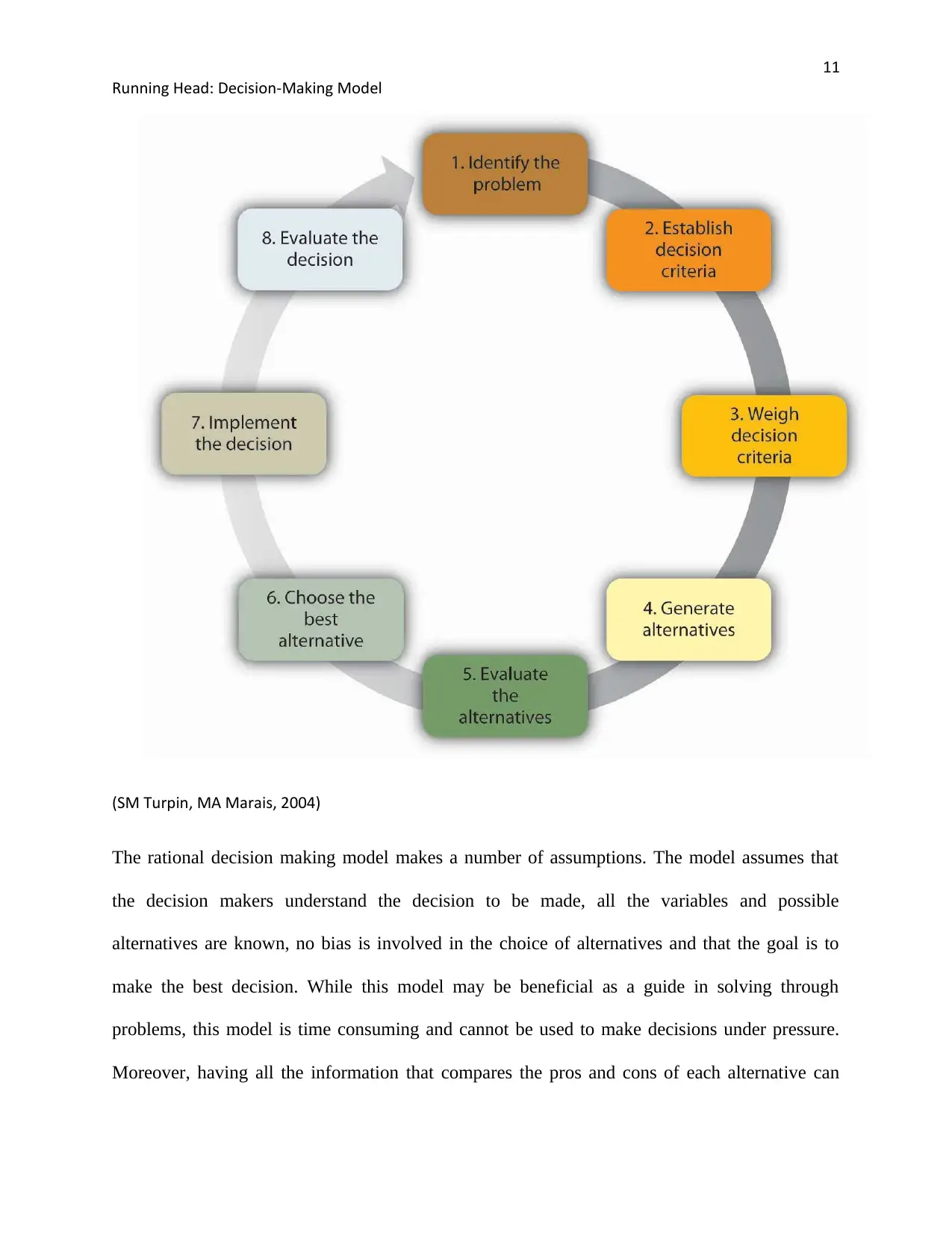
11
Running Head: Decision-Making Model
(SM Turpin, MA Marais, 2004)
The rational decision making model makes a number of assumptions. The model assumes that
the decision makers understand the decision to be made, all the variables and possible
alternatives are known, no bias is involved in the choice of alternatives and that the goal is to
make the best decision. While this model may be beneficial as a guide in solving through
problems, this model is time consuming and cannot be used to make decisions under pressure.
Moreover, having all the information that compares the pros and cons of each alternative can
Running Head: Decision-Making Model
(SM Turpin, MA Marais, 2004)
The rational decision making model makes a number of assumptions. The model assumes that
the decision makers understand the decision to be made, all the variables and possible
alternatives are known, no bias is involved in the choice of alternatives and that the goal is to
make the best decision. While this model may be beneficial as a guide in solving through
problems, this model is time consuming and cannot be used to make decisions under pressure.
Moreover, having all the information that compares the pros and cons of each alternative can
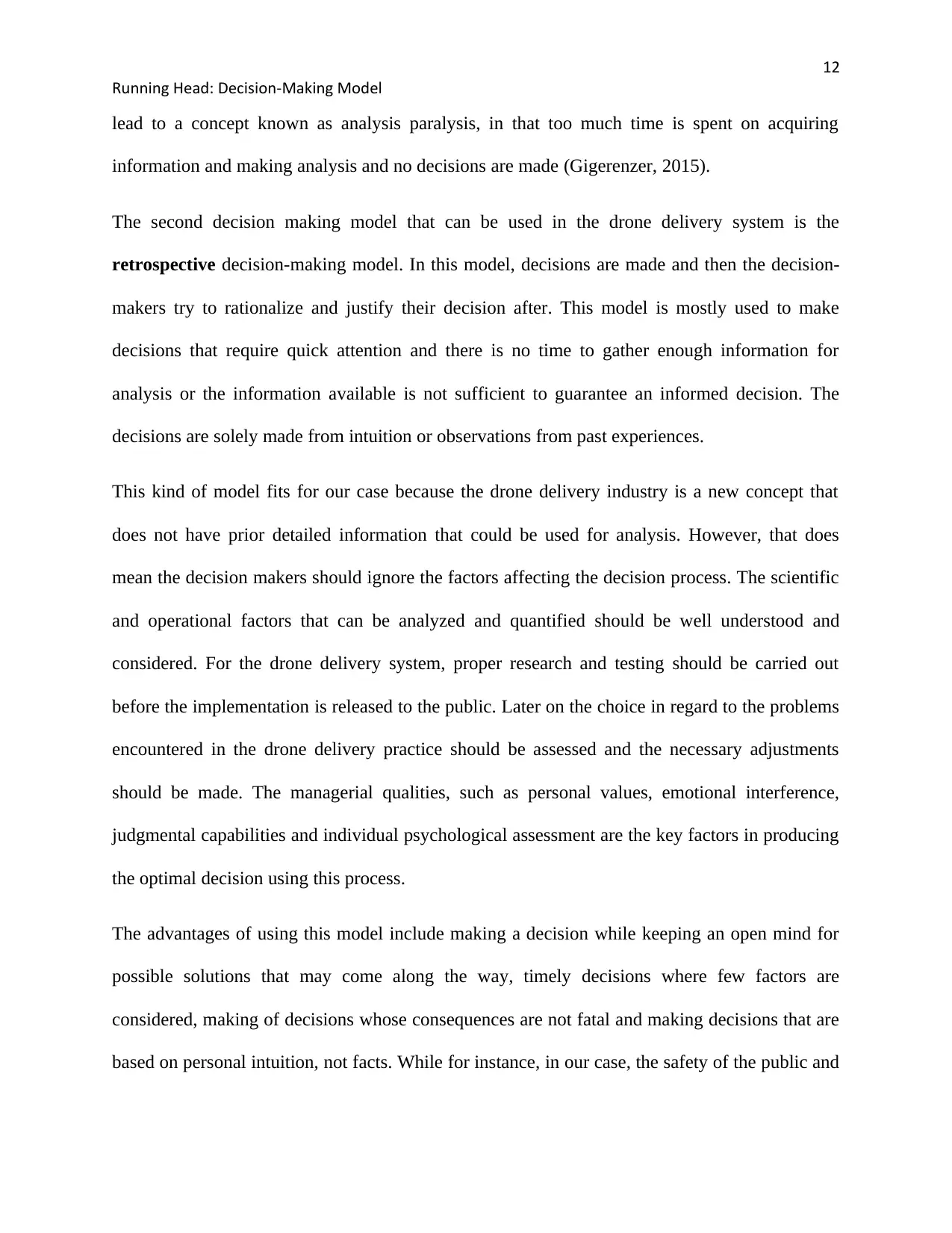
12
Running Head: Decision-Making Model
lead to a concept known as analysis paralysis, in that too much time is spent on acquiring
information and making analysis and no decisions are made (Gigerenzer, 2015).
The second decision making model that can be used in the drone delivery system is the
retrospective decision-making model. In this model, decisions are made and then the decision-
makers try to rationalize and justify their decision after. This model is mostly used to make
decisions that require quick attention and there is no time to gather enough information for
analysis or the information available is not sufficient to guarantee an informed decision. The
decisions are solely made from intuition or observations from past experiences.
This kind of model fits for our case because the drone delivery industry is a new concept that
does not have prior detailed information that could be used for analysis. However, that does
mean the decision makers should ignore the factors affecting the decision process. The scientific
and operational factors that can be analyzed and quantified should be well understood and
considered. For the drone delivery system, proper research and testing should be carried out
before the implementation is released to the public. Later on the choice in regard to the problems
encountered in the drone delivery practice should be assessed and the necessary adjustments
should be made. The managerial qualities, such as personal values, emotional interference,
judgmental capabilities and individual psychological assessment are the key factors in producing
the optimal decision using this process.
The advantages of using this model include making a decision while keeping an open mind for
possible solutions that may come along the way, timely decisions where few factors are
considered, making of decisions whose consequences are not fatal and making decisions that are
based on personal intuition, not facts. While for instance, in our case, the safety of the public and
Running Head: Decision-Making Model
lead to a concept known as analysis paralysis, in that too much time is spent on acquiring
information and making analysis and no decisions are made (Gigerenzer, 2015).
The second decision making model that can be used in the drone delivery system is the
retrospective decision-making model. In this model, decisions are made and then the decision-
makers try to rationalize and justify their decision after. This model is mostly used to make
decisions that require quick attention and there is no time to gather enough information for
analysis or the information available is not sufficient to guarantee an informed decision. The
decisions are solely made from intuition or observations from past experiences.
This kind of model fits for our case because the drone delivery industry is a new concept that
does not have prior detailed information that could be used for analysis. However, that does
mean the decision makers should ignore the factors affecting the decision process. The scientific
and operational factors that can be analyzed and quantified should be well understood and
considered. For the drone delivery system, proper research and testing should be carried out
before the implementation is released to the public. Later on the choice in regard to the problems
encountered in the drone delivery practice should be assessed and the necessary adjustments
should be made. The managerial qualities, such as personal values, emotional interference,
judgmental capabilities and individual psychological assessment are the key factors in producing
the optimal decision using this process.
The advantages of using this model include making a decision while keeping an open mind for
possible solutions that may come along the way, timely decisions where few factors are
considered, making of decisions whose consequences are not fatal and making decisions that are
based on personal intuition, not facts. While for instance, in our case, the safety of the public and
⊘ This is a preview!⊘
Do you want full access?
Subscribe today to unlock all pages.

Trusted by 1+ million students worldwide
1 out of 19
Related Documents
Your All-in-One AI-Powered Toolkit for Academic Success.
+13062052269
info@desklib.com
Available 24*7 on WhatsApp / Email
![[object Object]](/_next/static/media/star-bottom.7253800d.svg)
Unlock your academic potential
Copyright © 2020–2025 A2Z Services. All Rights Reserved. Developed and managed by ZUCOL.




